After months of teasing, General Motors on Monday officially unveiled the Cadillac Celestiq, an ultra-luxurious, zero-emission sedan meant to go toe-to-toe with high-end cars from Rolls-Royce and Bentley. It’s part of GM’s ambitious plan to sell only electric vehicles by 2030.
Cadillac is testing the limits of its brand allure and pricing power with the 2024 Celestiq – a large, bespoke electric car that will start at more than $300,000.
The vehicle – unveiled Monday night – launches the General Motors brand into the ultra-luxury segment against the likes of Bentley and Rolls-Royce. It’s something no American brand has successfully done in modern times.
Executives say the vehicle is more about creating a “halo car” that helps burnish Cadillac’s image, rather than fueling overall sales or profits. But, if successful, it could create a new two-unit business model for the company: one focused on hand-built, high-end vehicles and the other on mass-produced models.
Cadillac’s New $300,000 Celestiq Electric Car
“It is a brand builder. It’s a halo vehicle. It will lift people’s perception of the brand,” Rory Harvey, global vice president of Cadillac. “The business case has and continues to evolve, but it’s not just purely about the car. It’s about what it does for Cadillac and how it lifts the other Cadillac variants.”
Harvey declined to discuss the vehicle’s profit margins or whether the company plans to add additional hand-built models.
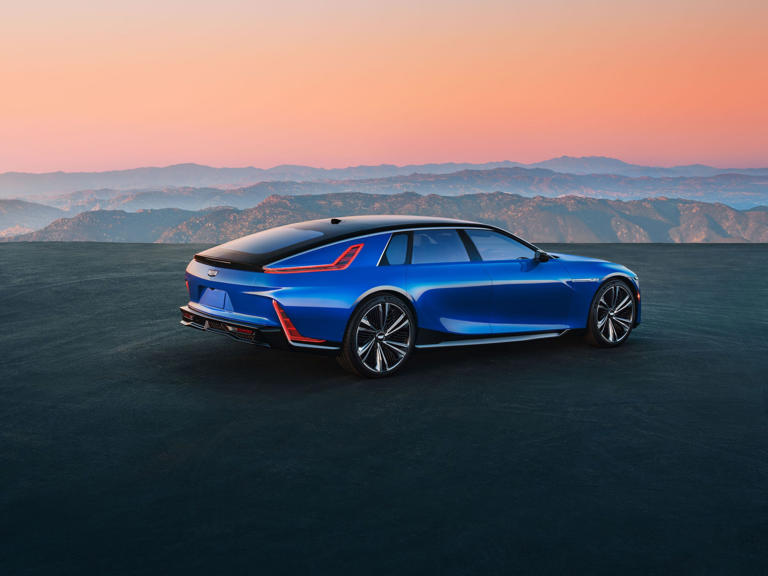 Image Credits: Cadillac
Image Credits: Cadillac
Customers will be able to customize nearly all aspects of the vehicle’s interior trim, exterior color and other nonmechanical elements. They’ll be able to work with designers and a Cadillac concierge to customize their vehicle.
New Upcoming Electric Cars in US 2023
“I don’t want to see this as a Mary Kay car, but the reality is, if you want to do an outrageous car, that’s the point,” said Michael Simcoe, GM vice president of global design, citing the unique “santorini blue” of the Celestiq unveiled Monday night.
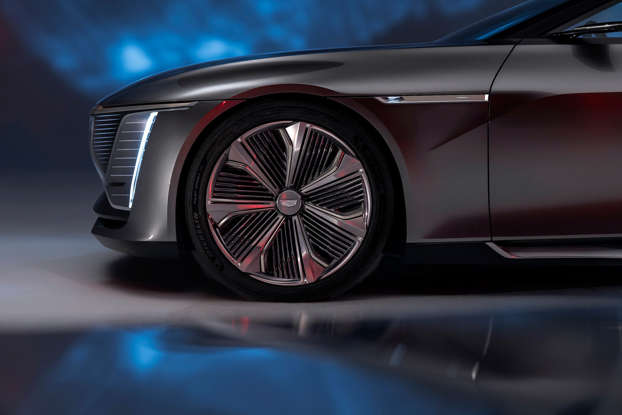 Image Credits: Cadillac
Image Credits: Cadillac
Despite growing concerns around the demand for new mass-market vehicles due to rising interest rates and record prices, ultra-luxury buyers have continued to spend.
What will customers get for that six-figure price tag? The all-electric sedan will feature a 600-horsepower, dual-motor, all-wheel-drive setup that can travel from 0 to 60 miles per hour in 3.8 seconds, and use the same Ultium platform that will underpin GM’s other future EVs. Cadillac estimates that the sedan can travel around 300 miles on a fully charged battery, and said it will be equipped with a 200 kW DC fast charging system capable of adding 78 miles in 10 minutes.
Here are five other features you didn’t know about the forthcoming Cadillac Celestiq.
Smart Roof
The Cadillac Celestiq will use the largest piece of automotive glass in the world, according to the company. The all-glass roof measures 7.5 millimeters thick – double the depth of a high-grade acoustic windshield – and uses Suspended Particle Device technology, a type of film invented by Woodbury, New York-based glass supplier Research Frontiers.
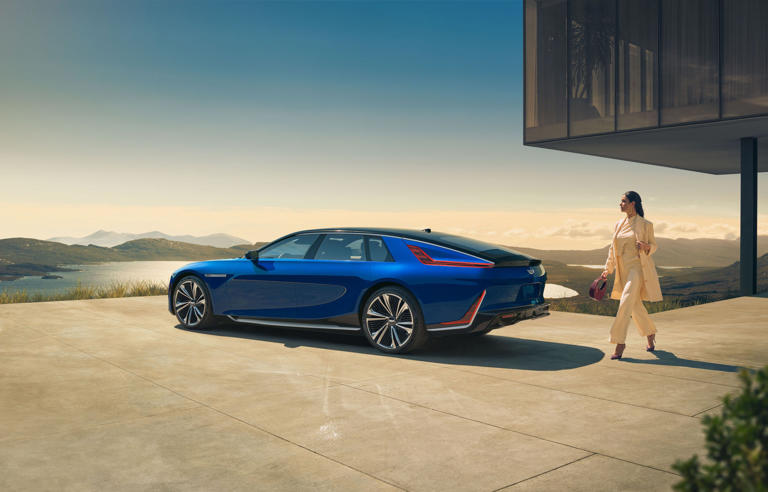 Image Credits: Cadillac
Image Credits: Cadillac
The film, which is already used in the roofs of certain models from McLaren, Mercedes-Benz and others, allows each passenger to adjust the overhead lighting by controlling the transparency of the glass, from less than 1%, for the darkest level of opacity to the 20% tint of a standard sunroof.
Privacy Blinds
Research Frontiers is also behind – or, in front of – the Celestiq’s five high-definition, interactive LED display screens. A 55-inch-diagonal screen that stretches pillar to pillar, unites two separate screens under a single pane of glass, with pixel density comparable to an 8K screen. Rear passengers get 12.6-inch seatback displays.
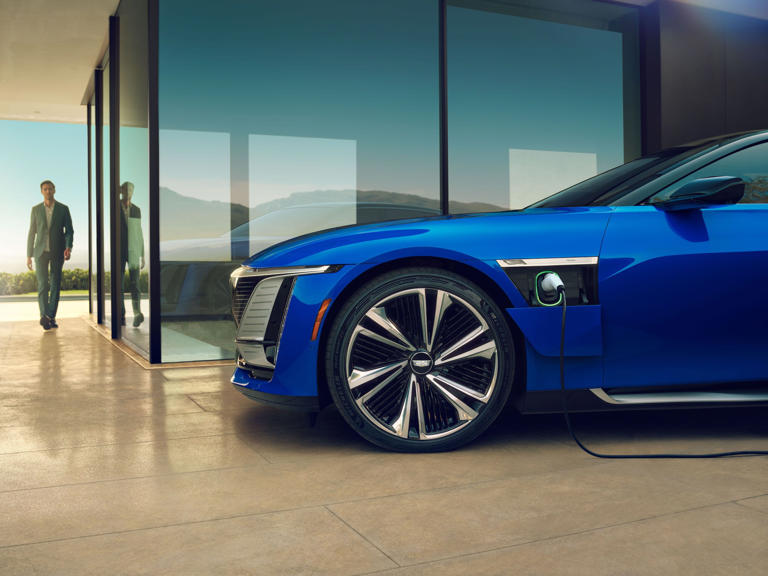 Image Source: Cadillac
Image Source: Cadillac
Lest these screens distract the driver, the car will employ electronic digital blinds – another application of Research Frontiers’ Suspended Particle Device technology – designed to let passengers consume content in private.
3D-Printing
The Celestiq’s spacious cabin will spotlight a 3D-printed steering wheel, GM’s largest-ever printed production part. Altogether, the car uses about 115 3D-printed components throughout its body, chassis, interior and electrical system. That includes the seat belt loop guide – GM’s first safety-related 3D printed part – as well as window switches and grab handles.
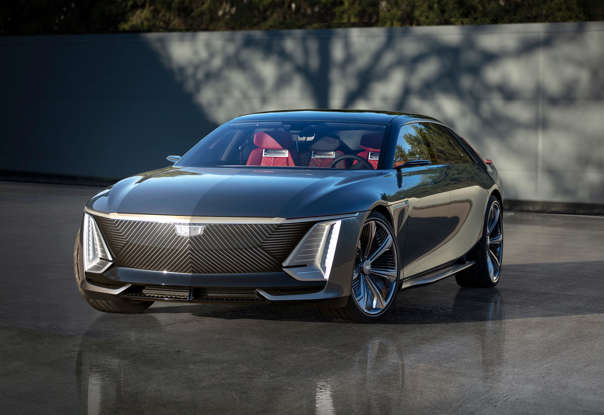 Image Credits: Cadillac
Image Credits: Cadillac
The architecture of the car’s underbody is designed to simplify the hand-built process. Its shock towers are constructed from six large cast aluminum components, with one shock alone supplanting up to 40 components from the overall body part count, according to Brandon Vivian, Cadillac’s executive chief engineer. This helps reduce weight and maximize space for more important features such as optional 23-inch forged aluminum wheels.
Ultra Cruise
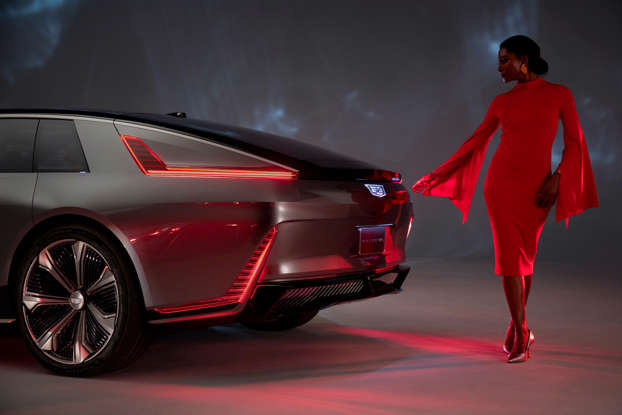 Image Credits: Cadillac
Image Credits: Cadillac
Cadillac executives said that the Celestiq will come equipped for eventual “driveway-to-destination” Level 4-style autonomous driving. The car will use Ultra Cruise, a hands-free driver assistance technology and successor to GM’s Super Cruise suite of hardware. Celestiq will also come equipped with the necessary Ultra Cruise hardware to provide incremental progress through over-the-air software updates.
Concierge service
Not all Cadillac dealers will carry the Celestiq.
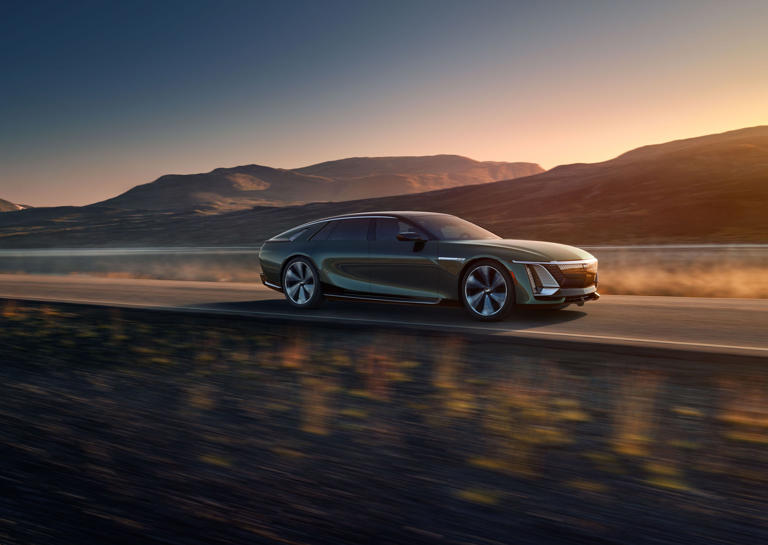 Image Credits: Cadillac
Image Credits: Cadillac
“All dealers will be offered the opportunity to be able to sell the Celestiq,” said Rory Harvey, global vice president for Cadillac. “There is a significant investment requirement, so we don’t believe that all dealers will want to take that opportunity.”
That investment includes retaining a concierge to help customize colors and materials. Cadillac said the Celestiq is available “by waitlist only.”
Low production
GM plans to only produce hundreds of Celestiq cars per year. It will only have capacity to build fewer than two vehicles per workday, Harvey said. The car will be sold globally, with the largest markets expected to be the U.S. and China.
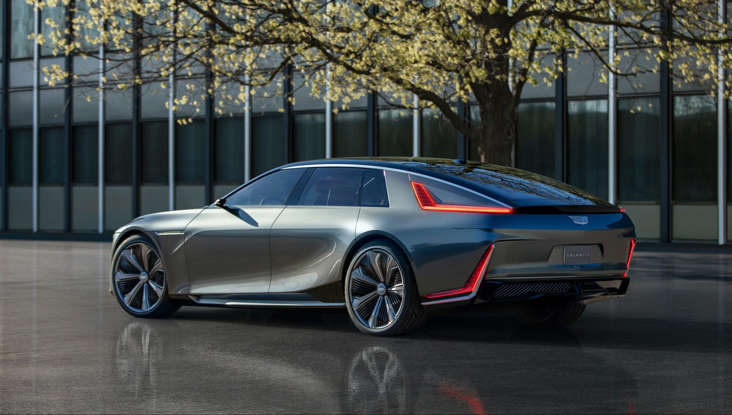 Image Source: Cadillac
Image Source: Cadillac
The Celestiq will be available by request only, with “a significant deposit” needed to begin the build process, according to Harvey. Ordering for the car will start as early as later this year, followed by production beginning in December 2023, according to GM.
In June, GM announced it would invest $81 million at its tech center in suburban Detroit to hand-build the Celestiq – marking the first time it will produce a vehicle for commercial sales at its massive campus in Warren, Michigan.
The vehicle features technologies including adaptive air suspension, magnetic ride control and rear steering to balance the ride comfort and performance of the car. It also includes 115 3D printed parts, including the metal center of the steering wheel of the vehicle.
 Image Credits: Cadillac
Image Credits: Cadillac
Cadillac has not sold a hand-built vehicle for decades, but its crosstown rivals have offered such cars as custom performance models. Stellantis’ Dodge offered “one-of-one” custom vehicle builds for its Viper sports car in 2015. Since 2016, supplier and contract manufacturer Multimatic Inc. has produced a hand-built, $500,000 GT sports car for Ford Motor, which is discontinuing the vehicle at the end of this year.
The Celestiq is Cadillac’s second all-electric vehicle following the Lyriq crossover going on sale earlier this year. They are the beginning of a new lineup of electric cars and SUVs for the brand as it plans to exclusively make all-electric vehicles by 2030.
Tech
The Celestiq, which GM previewed earlier this year, is big. At roughly 18 feet long and 7 feet wide, it is wider and longer than a Cadillac Escalade SUV. It is based on the automaker’s Ultium electric vehicle platform, but with an exclusive car structure.
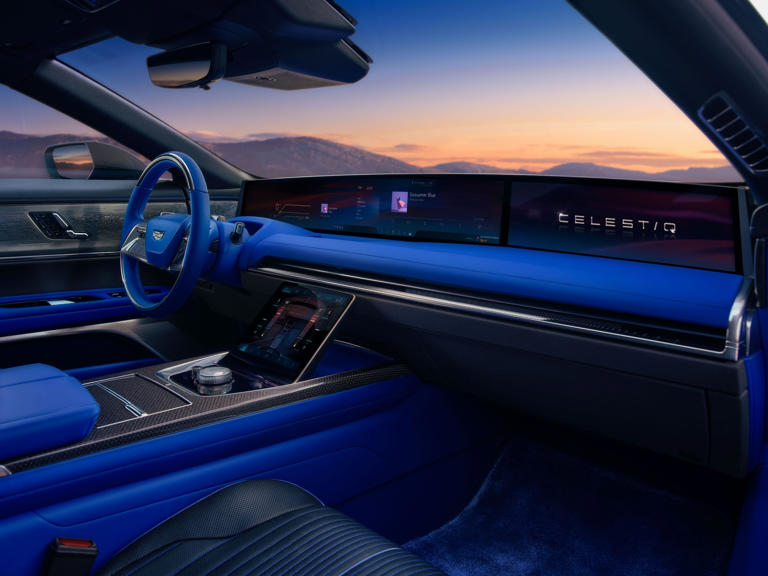 Image Source: Cadillac
Image Source: Cadillac
GM says the car is expected to achieve more than 300 miles on a single charge, with performance of 600 horsepower, 640 foot-pounds of torque and a 0-60 mph time of 3.8 seconds. The range and performance are lower than some current, less expensive luxury EVs such as the smaller $169,000 Lucid Air.
Noticeably missing from the Celestiq are exterior door handles. Instead, owners can open the doors by pressing a button or have doors open automatically as the driver approaches the vehicle with a key fob, according to GM.
The Celestiq features five LED interactive displays, including a 55-inch diagonal screen spanning the front cabin of the car; a “smart glass roof” that includes customizable transparency options; and Ultra Cruise, GM’s next-generation advanced driver-assist system that the company has said will be capable of driving itself in most circumstances.
“When we started this process, the brief then we gave to the team was to develop the most epic Cadillac ever,” said Brandon Vivian, Celestiq executive chief engineer. “But the result is a vehicle unlike any other. … It’s a custom-commissioned celebration of the client’s individuality.”
Vivian said Ultra Cruise’s capabilities will build up over time. He declined to discuss how different the system will be compared with GM’s current Super Cruise system, which allows users to keep their hands off the steering wheel while driving on pre-mapped divided highways.
Ultra Cruise should be far more capable than the current system, as it’s expected to build on Super Cruise’s software and sensor suite by adding lidar, or light detection and ranging systems, that can sense surroundings and help cars avoid obstacles.
A blend of old and new
While Cadillac has a strong history of hand-built custom coachwork that stretches to its very beginnings, this is the first modern vehicle with an all-electric powertrain that blends both modern technologies with bespoke customization.
 Image Source: Cadillac
Image Source: Cadillac
Underpinning the Celestiq is GM’s Ultium battery technology, albeit in a different layout than other GM vehicles.
Tony Roma, Cadillac’s Chief Engineer, told TechCrunch that the company has actually been showing off the battery layout for Celestiq for two years, but no one ever asked about it.
The batteries are stepped across the underbody of the vehicle rather than laid, pancake-style in the chassis. The front portion of the battery pack is lower than the portion under the rear seats, and there’s an additional battery pack laid lengthwise under the middle of the vehicle, mimicking a transmission tunnel.
The dedicated EV architecture combines a 111-kWh battery pack and a two-motor, all-wheel-drive system. GM estimates that the Celestiq will put out 600 horsepower and 640 pound-feet of torque and get around 300 miles on a full charge.
Cadillac says that the Celestiq will travel 0 to 60 miles per hour in around 3.8 seconds. The company also says that on DC Fast charging, the Celestiq will gain as much as 78 miles of range in only 10 minutes.
That’s impressive, considering that everything on the vehicle that looks like metal is, in fact metal, adding to an already hefty weight. Most auto manufacturers will make things like trim and interior bits out of lighter weight plastics and coat them to look like metal. That’s not the case for the Cadillac Celestiq. Executive Chief Engineer Brandon Vivian noted during our preview, that is intentional. ”
This is the flagship for Cadillac and we want it to be authentic and genuine,” Vivian said.
The company used a blend of additive manufacturing, stamping and casting to make everything from the body-in-white, to the aluminum steering wheel inlay and the compound curve body panels.
Additive manufacturing is essentially 3D printing, and according to Roma, the technology wasn’t really feasible for the project until about a year and a half ago. When the technique became available, Cadillac was able to pivot and use it in the build. There are 115 3D-printed parts on the Celestiq.
The evolution of additive techniques has also enabled Cadillac to offer even more bespoke features. “If you wanted your name or some sort of design cut into the steering wheel or the metal piece under the vents, we can do that. Because we can just print it into the file itself, and it’s not like I have a tool it all up,” Roma said.
Technology and packaging
“One of the most challenging aspects of designing the Celestiq was packaging a good-looking body around all of the technology,” Erin Crossley, the Design Director for Celestiq, told TechCrunch. That technology includes everything from the fixed glass roof that has four separate panels that can be individually turned opaque, patterned, or open, based on the preferences of those inside, to the 55-inch diagonal screen that stretches across the dash of the Celestiq.
Cadillac also says that the Celestiq will be equipped with the latest in Super Cruise technology, GM’s advanced driving assistance system that is as close to self-driving as is realistically possible, today.
 Image Credits: Cadillac
Image Credits: Cadillac
The Celestiq will come with Ultra Cruise, which will build on GM’s Super Cruise, and allows for hands-free driving on mapped highways and divided roadways. Ultra Cruise will allow drivers to drive hands-free in the city. Cadillac says that the “vehicle will be equipped with all of the necessary Ultra Cruise hardware to enable incremental feature growth via over-the-air updates in 2024.”
The Celestiq will also include automatic remote parking, which allows the driver to be out of the vehicle while letting the car park itself in a parallel or perpendicular space.
China ambitions
While Cadillac has struggled to regain its Standard of the World moniker, at least here in the U.S., the company’s vehicles are popular in China, and it’s easy to see how the Celestiq may fit into the company’s global ambitions.
Its long, low roof and fastback design, with everything from retractable tray tables that nestle into the center armrest in the rear seat to individual screens at each seat, indicate that Cadillac is thinking about those buyers who prefer to be driven, rather than drive themselves.
 Image Credits: Cadillac
Image Credits: Cadillac
When asked about ambitions for overseas markets, representatives for Cadillac said, “Celestiq will first be available in North America. As a global brand, we will look at expanding to other global markets later in the product lifecycle, including China and the Middle East.”
Cadillac says it will begin building the Celestiq at the end of 2023, and orders can be placed through dealers. Interested parties will then connect with a concierge service that will either guide them through the designing process or use an in-house developed AI to help them narrow down the multitude of options for color, finishes, materials, and customization.
As customers further customize their Celestiq, the price tag will climb above the $300,000 starting price.
While that price tag is well out of reach for most car buyers, Cadillac did say that a lot of the technology that the company used in developing the Celestiq will show up in more attainable vehicles as well. The manufacturing techniques, as well as some of the packaging and technology, is likely to show up in future Cadillac vehicles priced for those of us who are mere mortals.

Pingback: Rolls Royce Electric Car to go on sale next year 2023 - Best Electric Vehicle